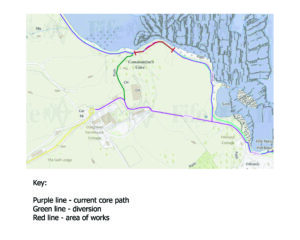Elie to Cambo Sands
Please be aware that there is a temporary closure of the Fife Coastal Path at Crail Golf Club to allow essential coastal coastal works due to Health and Safety. The works are expected to last from 1st November 2025 to 31st March 2026.

You will be led through quaint little fishing villages on the Elie to Cambo Sands (also known as Kingsbarns) section of the Fife Coastal Path.
This section can be rough underfoot. It is full of geological, historical and wildlife interest, but it also includes several short sections of stone steps that may be uneven or slippy. Therefore, stout footwear is essential, particularly in winter. Allow 5 – 6 hours. Get a flavour of the route by joining Lloydi as he walks this section of the Fife Coastal Path.
Famous
The Elie to St Monans section begins at Ruby Bay, once a site famous for Red Garnet gemstones. Follow the path, taking a recommended and short detour to Elie Lighthouse and Lady’s Tower. The tower was built for Lady Janet Anstruther as a summer house in the 1760s.
Further on are the ruins of Ardross and Newark Castles. The route from here to St Monans has a high tide diversion. This diversion borders fields, crosses a bridge and rejoins the low tide route near the stunning 14th century St Monans Church.
Pass the restored St Monans Windmill, once used to pump seawater into the adjacent salt pans. The limestone beds here are rich in fossils. The next village of Pittenweem is Fife’s only working fishing harbour and is the site of a cave used by St Fillan in the 7th century.
Picturesque harbour
Skirt the golf course and the rocky shore past Billow Ness to the four old Royal Burghs which constitute Anstruther. This popular tourist village is noted for its award-winning fish and chips, Scottish Fisheries Museum and the Reaper. The Reaper is a herring drifter built in 1900 and used in the filming of the hugely popular Outlander series. From Anstruther, there are daily boat trips during the summer months to the Isle of May National Nature Reserve.
Pass through Cellardyke, with its picturesque harbour, towards Crail and onto open pasture. Please be cautious as livestock may be present. Caiplie Caves are a prominent weathered sandstone feature situated almost halfway between Cellardyke and Crail. The route continues past an old salt works before winding its way via some stone steps to Crail, a traditional fishing village with a 17th-century harbour.
Challenging
The path leading onto Fife Ness is challenging in places with narrower and altogether rougher terrain. It passes through the Scottish Wildlife Trust’s Kilminning Coast Wildlife Reserve and users should note that sheep and cattle graze the area at certain times of the year.
You are now at the most easterly point in Fife and the path passes King Constantine’s Cave where he was killed in around 874. Beyond the golf course, the route continues along the shore beneath the Randerston cliffs. Walkers should wait for low tide before attempting this section. The path then leads to a bridge over Cambo Burn then continues along a sandy track through the dunes. Cambo Estate is a great place to stop off for a rest, lunch or to explore the gardens and estate. An alternative route follows Kingsbarns beach.
It is possible to park overnight in the marked overnight bays at Kingsbarns, to find out more visit our overnight parking webpage. And before you set off please visit our Stay Safe in the Countryside page for things to consider when you are in the outdoors.
Visit Leuchars to Wormit Bay to learn about Tentsmuir National Nature Reserve and to plan your journey along the next section of the Fife Coastal Path.